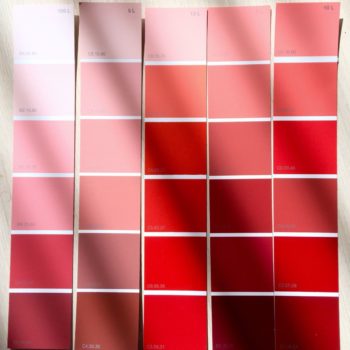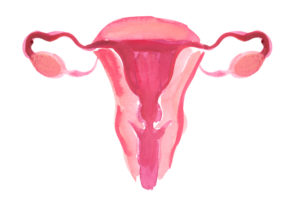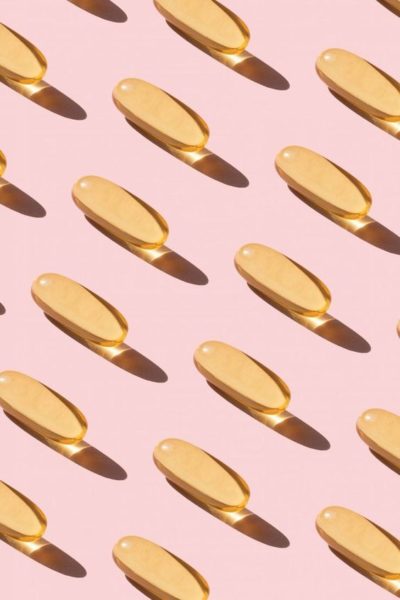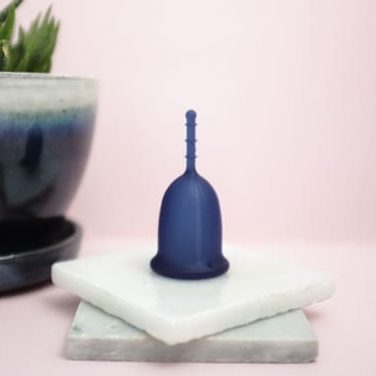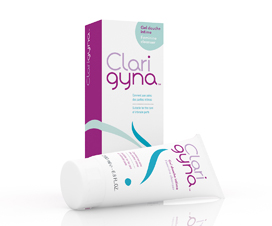That’s it, your period has arrived ! With varying degrees of regularity, pain or fatigue, they are often an indicator of your overall health. For your well-being and health, it is important to know your rules.
Menstrual cycle, how does it work?
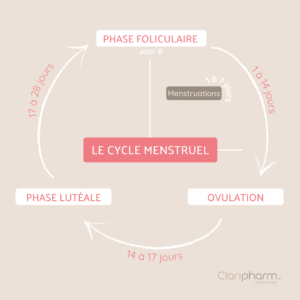
The menstrual cycle is a period between the first day of menstruation and the first day of the next period. The menstrual cycle is not just blood, so it doesn’t just span the menstrual period but a longer period. It is important to know and understand your menstrual cycle. It is a major indicator of our health and knowing it well allows us to better understand and manage it.
The cycle may be irregular, but there is often a cause for this. It is generally said that a menstrual cycle lasts 28 days, but this is actually not the norm for most women. The duration of a cycle is rather between 21 and 35 days.
What is the menstrual cycle?
A woman’s life is made up of cycles that break down into 4 phases. Each of these phases is marked by hormonal changes.
1. Periods
Day 1 to 7
This first phase marks the beginning of the menstrual cycle.
During this first phase, the endometrium, the tissue that covers the inner wall of the uterus, thickens. If there is no embryo, the endometrium self-destructs each month and flows with a little blood from the uterus through the vagina: this is the menstrual period.
Menstruation usually lasts from 2 to 7 days. If you have painful periods, they will surely occur during the first few days. Hormones in the body cause the elimination of the endometrium, which is what hurts.
The first period arrives on average at the age of twelve, but this is still an average, they can arrive much earlier or much later without having to worry about it. Some girls will have their first period at 9 years old, others at 13 years old, it’s nature that decides.
One season: winter.
2. Pre-ovulatory phase, also known as the follicular phase.
Day 1 to 14
This phase extends from the first day of menstruation until ovulation.
During this period, the body produces more estrogen and less progesterone. Estrogen will boost your energy.
As a reminder, estrogen is a hormone secreted by the ovary, ensuring the formation, maintenance and functioning of the female genital organs.
Progesterone, on the other hand, is a sex hormone that prepares the uterus for a possible pregnancy. It is secreted by the corpus luteum, the follicle after ovulation in the second part of the menstrual cycle.
The pre-ovulatory phase lasts an average of 14 days. During this phase, cells called follicles present in both ovaries will develop under the action of a molecule. At the same time, the endometrium thickens for possible fertilization.
One season: Spring
3. Ovulation
Day 14 to 17
It is common to hear that ovulation occurs on the 14th day of the cycle but this is only an average, it can vary, generally ovulation does not occur beyond the 17th day. Some women feel slight pain at the time of ovulation, but many feel nothing, there is no sign of ovulation.
In this phase of ovulation, you should feel like in the summer, serene with great energy and self-confidence, ready to face anything. It only lasts a few days, the small days when your uterus will be ready to receive an embryo, this is the best time if you are looking to get pregnant. This is when the egg leaves the ovary and begins to travel to the uterus.
On the 14th day, only one of these follicles matures and ruptures. It will then expel an egg into one of the two fallopian tubes (the uterine tubes that connect each ovary to the uterus). Once emptied, this follicle will then turn into a corpus luteumand we are halfway through the menstrual cycle.
One season: summer
4. Luteal phase
Day 17 to 28
This phase begins after ovulation and ends when menstruation arrives.
The corpus luteum, which we have just talked about, starts to produce a hormone that will act directly on the uterine lining. This will continue to thicken to accommodate a possible future embryo.
Progesterone is in the majority and the drop in estrogen will lead to premenstrual symptoms (=PMS), headaches, loss of energy, small pimples, breast pain, bloating and irritability. That moment when you just want to be in bed watching a movie with a nice hot tea, isn’t it autumn?
It is important to know your cycle, so you will know that during this phase it is time to take care of yourself :).
If the egg is not fertilized by a sperm, the corpus luteum atrophies and the progesterone level drops. Then comes the menstruation …
One season: Autumn
Of course we are all different and do not all react in the same way. Neither are we robots and not all of us are perfectly tuned. Stress, diet, lack of sleep, travelor a change in activity can affect it. But following your cycle will allow you to better understand your body and how the 4 phases of the cycle affect it. So you can keep a small calendar or use an application like Cluewhich is great for tracking your symptoms and calculating your cycle.
50 Shades of Red – The Color of the periods
That’s it, your period has arrived! With varying degrees of regularity, pain or fatigue, they are often an indicator of your overall health. For your well-being and health, it is important to know your periods, their average duration, the amount of blood you lose or their usual color, so that you can react if a change occurs. The explanation may be simple (change of contraception, menopause…), or a sign that something is wrong and should be consulted.
Among the different signs to observe is the color of your periods: you may have noticed that their color varies during your cycle, but does that mean something for your health? Here we explore with you how this happens, and when to react.
It is normal for the color of your rulers to change during your cycle.
Let’s start by recalling the (simple) basics: from adolescence to menopause, the female body is governed by sex hormones that trigger a succession of menstrual cycles whose purpose is simple: to conceive life. With each cycle, the body prepares a cozy little nest in the uterus in case an embryo wants to develop into a fetus. If there is no embryo, the endometrium (= the cozy little nest) self-destructs, and flows with a little blood from the uterus through the vagina: BINGO is menstruation (and you are not pregnant).
The different shades of red that you may observe are generally due to the length of time your period is in contact with oxygen. A bit like when you cut yourself: the blood runs red at first, then reacts and dries on contact with the oxygen in the air (it oxidizes), taking on a dark red or brown color. It is therefore quite normal to observe, during a period of menstruation, different nuances.
Dark red to brown periods
This is usually the color observed during the first day or towards the end of menstruation and is quite usual. This is only a sign that the menstrual blood took a long time to evacuate and therefore oxidized. The endometrium does not disintegrate all at once, it is a slow process to start and stop.
This is also the color you probably see when you use towels. It makes sense: by settling in a towel, menstrual blood has more contact with oxygen than when it is collected in a menstrual cup or absorbed by a tampon.
You can also observe dark red (sometimes black) clots, and again: don’t worry. It is the endometrium that is evacuated and it is normal to observe a few clots during the days when your flow is most abundant.
On the other hand, if these clots are accompanied by pain, irregular, very long and abundant periods, it is possible that they are due to a fibroid. In this case, we recommend that you consult a health care professional. Fibroids are (usually) diagnosed through a simple gynecological examination.
You may notice a few brown drops if you start/change contraception or if you are approaching menopause. This is normal: any hormonal change tends to provoke some losses without seriousness.
Bright red periods
This is when the serious stuff starts and your flow intensifies.
Increased menstrual flow = faster evacuation with less oxidation. Everything is working as planned!
When you started using a menstrual cup, you may have felt that your period was redder than before. It’s normal! Once collected in a menstrual cup, the menstrual blood is in contact with little oxygen and oxidizes less (which also prevents odors).
If you experience bright red spotting between your periods, you should consult a health care professional as there are several possible causes for this unexpected bleeding, including some sexually transmitted infections.
Pink Periods
You have periods like diluted, less abundant and have started training for a marathon? Don’t look further! Intense physical activity can lower your estrogen levels, which decreases your flow and can even stop your periods. This is common among top athletes. It may seem very convenient to have fewer or no periods at all, but low estrogen levels increase the risk of osteoporosis. Osteoporosis is a disease that affects the bones and makes them more fragile. This is a frequent consequence of menopause, a period of life during which the levels of sex hormones (including estrogen) also decrease. It is therefore important to be accompanied by a doctor if you think your periods have decreased in intensity because of sport, so that you can be monitored over the long term and avoid any deficiency or fracture.
What if you’re not really athletic? Other causes can explain pink periods: sudden weight loss, polycystic ovary syndrome, or the onset of premenopause. In all cases, we advise you to be accompanied by a health professional.
Grey periods or losses
You’re a little past your period, but at any time during your menstrual cycle, if you have a gray or grayish discharge mixed with blood, we advise you to go see a doctor quickly, because it could be a sign of a vaginal bacterial infection or a miscarriage. If you are or think you may be pregnant, consult your doctor as soon as possible.
Vaginal bacterial infections are common in women and many treatments are available. If you know you are predisposed to this type of infection, consider a few simple hygiene measures, such as using an intimate soap with an acidic pH. By using a soap with an acid pH, you preserve your natural intimate flora, an important defense against infections.
Blue Periods
Blue periods?! No no no, that’s only in commercials! Frankly, advertisers, this is the 21st century and we can show red blood. Don’t forget that we see them every month!
As you will have understood, it is completely normal to observe different shades of red during your period. It is especially if you observe traces of blood without explanation between your periods or during pregnancy that you should seek medical advice.
Pay attention to other signs, such as the amount of blood you’re losing (a common practice with Claricup!), the pain that can accompany menstruation and its duration or regularity: an abrupt change can be a sign that it’s time to make an appointment with your doctor. And you will know this over time by listening to your body to better understand it, and this is the best way to ensure your well-being!
First Menstruation – What you need to know about puberty
A woman’s life is made of cycles. During puberty the first menstruation occurs, a sign of the beginning of the fertility cycle. It is a natural phenomenon that will accompany you every month until you are no longer fertile.
But let’s go back to the beginning, to fully understand what’s going on in your body…
First of all, what is puberty?
Puberty, which happens to both boys and girls, is the transition period from childhood to adulthood. It usually starts between the ages of eight and fourteen in girls1. It is an important stage of life where the body changes. In girls, puberty is triggered when the brain starts producing hormones that act on the ovaries (the two sex glands located on either side of the uterus). They then begin to produce sex hormones called estrogen and progesterone. It is these hormones that “trigger” and regulate the menstrual cycle.
What is a menstrual cycle?
The menstrual cycle is the period between the first day of menstruation and the first day of the next period. The menstrual cycle lasts an average of 28 days. It can be broken down into four phases:
The pre-ovulatory phase (also called the follicular phase):
It lasts on average 14 days. During this phase, cells called follicles present in both ovaries will develop under the action of a molecule. At the same time, the lining of the uterus, also known as the endometrium (the outer wall of the uterine cavity) thickens for possible fertilization.
Ovulation
On the 14th day, only one of these follicles matures and ruptures. It will then expel an egg into one of the two fallopian tubes (the uterine tubes that connect each ovary to the uterus). Once emptied, this follicle will then turn into a corpus luteumand we are halfway through the menstrual cycle.
The luteal phase
It lasts on average between 10 and 16 days
The corpus luteum, which we have just talked about, starts to produce a hormone that will act directly on the uterine lining. This will continue to thicken to accommodate a possible future embryo. If the egg is not fertilized by a sperm, the corpus luteum atrophies and the progesterone level drops.
Menstruation
This drop in ovarian hormones causes the thick part of the uterine lining to detach: it drains through the cervix and then through the vagina in the form of “blood”. Yes, those are the periods !
The first period arrives on average at the age of twelve, but this is still an average, they can arrive much earlier or much later without having to worry about it. Some girls will have their first period at 9 years old, others at 13 years old, it’s nature that decides.
As you can see, this cycle lasts about (again, this varies from woman to woman) 28 days. This means that from the moment you have your first period, you will have it (in principle, but there may be exceptions) every 28 days during your life as a fertile woman.
What does the first period look like? What is their quantity? How long do they last?
These are obviously questions we ask ourselves when we have never had our period since it is not always a very easy subject to discuss. It is even sometimes referred to as the “taboo” of periods. Fortunately, more and more people around the world are talking about it publicly and explaining this phenomenon which, after all, is quite natural!
Menstruation lasts an average of two to seven days(again, this is an average) with a more abundant flow at the beginning. The blood is a bright red color at the beginning of menstruation and then, over the course of the days, tends to darken as the flow diminishes. Sometimes there are small clots that mix with the blood: don’t worry, it’s a completely natural phenomenon.
The amount of blood lost during menstruation varies from 20 to 70 ml2. The average is considered to be 50 ml, the equivalent – to help you visualize – of ten teaspoons.
During the first cycles, menstruation is generally less abundant.
To avoid staining your underwear and clothing, there are several solutions that will “capture” the flow of your period and allow you to go to school, go out, play sports, run, jump…with confidence.
Among them is the Mini Claricup (size 0), developed by the Claripharm laboratories, which is specially adapted for first periods and light flows. It is a small flexible cup that is inserted into the vagina and collects the flow. Made of antimicrobial silicone, it is proposed with its disinfection box. It is a protection that is both very secure and easy to insert: it doesn’t move once installed and allows you to play sports in complete safety, for example.
You can also use sanitary napkins. The pad is an absorbent external protection that is placed directly on the panties. It exists in different sizes, adapted to the volume of the periods.
1 – Figures from Inserm (National Institute for Health and Research)
2- Source Larousse Medical.
Abundant periods: causes and solutions
Today 30% of women consider that they have heavy periods.
The scientific community considers menstruation to be too abundant compared to normal when you lose more than 80ml of flow per cycle, (or if menstruation lasts more than 7 days) which is equivalent to 6 tablespoons. Admittedly, it is not simple to measure the amount of blood lost with a tablespoon … Measuring the amount of blood lost with a cup remains much simpler!
To help you quantify your flow :
-
Users of menstrual cups :
If you use a menstrual cup, it will be very easy to know how many ml of menstrual periods you lose because we indicate the capacity of our menstrual cups.
Claricup T0 has a capacity of 13.5 ml, Claricup T1 has a capacity of 20.2 ml, Claricup T2 has a capacity of 29.5 ml and Claricup T3 has a capacity of 36ml. So all you have to do is find out how many times you empty it per day, see roughly how full your cup is and do the calculation on your cycle.
-
Users of tampons or towels :
If you use super absorbent tampons or pads that you change every hour or every 2 hours, you have a very abundant flow. Sometimes, some women place 2 tampons at the same time (yes you read correctly), which is of course contraindicated. In this case too, we can speak of a very abundant flow.
Causes
The abundance of your periods varies over the course of a cycle, as does the color of your period, which is normal. Just as it is normal to observe variations in flow according to individuals, age, or different periods in a life, such as :
- The first periods,
- After the insertion of a copper IUD,
- In Pre-Menopause,
- In Post-Childbirth,
But also when following a certain diet, exercising, or taking hormonal contraceptives.
As you may have noticed, it’s a matter of hormones in many cases ! These are progesterone and estrogen.
Estrogen gives the physical female characteristics and orchestrates the menstrual cycle. Although estrogen acts mainly on the breasts and uterus, it also acts on the brain (effect on mood) and the heart (protection of the cardiovascular system).
A high level of estrogen will cause an increase in menstrual flow.
In the same way, a low progesterone level will imply the development of estrogens which will be more dominant.
We told you about the first periods earlier. Yes because puberty leads to a consequent hormonal upheaval. This is when the body is transformed to become capable of procreation. During this upheaval, the hormones try to regulate themselves but it is the estrogen level that is the highest, the first periods can then be quite abundant. However, this only lasts for a while. Eventually, the hormones are balanced, and everything is back to normal.
The same applies to the post-partum period. A woman’s body after birth has undergone many changes, we are talking about it here and there. The lochies occur, then the “real” periods come back. These may be different from the rules we have known before. Include: Niagara Falls. (By the time the hormones are regulated after childbirth, some women have thyroid dysfunction).
After the insertion of an IUD, it’s different: a copper IUD causes a change in the endometrium, the mucous membrane that detaches at the end of each menstrual cycle (which triggers menstruation). This modification of the endometrium prevents the development of an embryo (this is the contraceptive effect) but also prevents heavier periods than before the IUD was inserted (this is the KissCool effect). This is one of the reasons why many women become cup users. Just in case you’re wondering, There are no contraindications to wearing a cup and IUD. We explain why here.
Pre-menopause: It is again the great upheaval of hormones.
The production of progesterone is less due to a more random ovulation, while the secretion of estrogen is still satisfactory, menstruation can therefore be very abundant. But they can also disappear, reappear, become weaker… It is a period of hormonal imbalance that is totally unpredictable.
As soon as there is a hormonal change (change in hormonal contraceptives, hormonal imbalance, pre-menopause, etc.), a change in the abundance of menstrual flow can be observed.
But how do you know if this abundant flow is normal or if it is abnormal?
When to consult ?
Too much blood loss can lead to intense fatigue caused by iron deficiency. This is referred to as anemia. If this is the case, your periods are abnormally heavy, it is then time to go see your doctor. He will help you and accompany you in the search for a solution.
If your flow is much more abundant than what we defined previously (+80ml or more than 7 days), it may be a sign that something is wrong. We think of a thyroid disorder, fibroid, endometriosis, polyp. Do not hesitate to consult your health care professional.
Solutions
With our expertise and our desire to accompany you throughout the life of your vagina, we have sought solutions for your heavy periods.
Following your requests, we have created a new menstrual cup size, one size bigger than the others, the Claricup Size 3!
The most absorbent tampons can collect up to 15ml. The Claricup size 3 has a capacity of 36ml! Twice the capacity of a super absorbent pad.
If you do not wish to change the abundance of your flow (with a hormonal contraceptive for example), the Claricup size 3 is therefore one of our solutions for your heavy periods. Beware, it is not because the capacity of our cup is bigger that we have to change it less often! The Claricup is still to be emptied every 6 hours. (read our article on wearing time here).
How do you manage your Niagara Falls? 😉
My period is late! 6 reasons other than pregnancy
You were ready: your Claricup menstrual cupdisinfected in one hand, hot chocolate in the other, you were ready to live quietly your period this month. And then when the day comes… nothing. Calendar error? Contraception error? All the scenarios start scrolling through your head and panic mounts. STOOOP ! There are many possible explanations other than pregnancy.
To better understand why the rules are not triggered at the time they were calculated, it is important to go back to their triggering mechanism :
From adolescence to menopause, the female body is governed by sex hormones that trigger a succession of menstrual cycles whose purpose is simple: to conceive life. Every 28 days or so, your ovaries release an egg to be fertilized and your uterus prepares a cozy little nest in case the fertilized egg develops there. If the egg is not fertilized by a spermatozoon, the endometrium (= the small, soft nest) self-destructs and runs out with a little blood: this is the menstrual period. Menstruation is a sign that you are not pregnant.
But being late with your period is not necessarily a sign that you are late.
Adolescence or menopause
One of the simplest explanations is that you are in one of these two transition phases: it is perfectly normal to have irregular periods during adolescence or menopause.
In adolescence, it takes a little time, sometimes a few years, before menstrual cycles are well established. At menopause, they gradually stop and often get longer. And in these two cases, it is difficult to calculate anything! Do not hesitate to ask for advice from a health professional to accompany you through these stages of your intimate life that come with many changes.
Stress
There are two types of stress: acute stress, in response to a specific event, and chronic stress, which occurs when we are constantly subjected to situations for which we are not prepared. However, our body is not made to be stressed all the time. Chronic stress is therefore harmful because, like a domino effect, it disrupts important body functions, including the menstrual cycle and periods1. Which kind of makes sense: if you’re stressed all the time (sometimes even without realizing it), your body feels like you’re in a situation that’s totally unsuitable for having a baby. It stops ovulation and thus stops menstruation. If you can identify the cause of the stress and manage it, your periods will return naturally.
If you can identify the cause of the stress and manage it, your periods will return naturally.
Flight attendants and nurses are familiar with this problem: changes in the pace of life disrupt not only sleep, but also the rules. Indeed, nearly 53% of women working staggered hours observe changes in the rhythm of their periods2. People with staggered schedules have fragmented and shorter than average sleep. However, it is during sleep that the hormones that trigger ovulation are secreted. So don’t worry if your period is late after a trip to the other side of the world: your ovaries are also out of sync!
You play sports intensively
This situation has been evoked in article 50 shades of red: the consequence of intensively practiced sport is to reduce the volume of menstruation, to make it irregular or even to make it disappear3. This is due to a deficit in available energy, which decreases the secretion of sex hormones. These deficits lead not only to irregular or non-existent periods, but also to other disorders that specialists call “The Female Athlete Triad”: insufficient energy intake and disorders of the menstrual cycle associated with osteoporosis. It is therefore important to be accompanied by health professionals who will be able to advise you on how to reduce your training volume and adapt your diet to your energy expenditure, which will allow your periods to return naturally.
Extreme weight gain or loss
Whether one way or the other, a rapid weight change is a stress for the body, which has no time to adapt to these sudden changes. It will therefore stop producing sex hormones (in case of extreme weight loss) or, on the contrary, produce too much (in case of obesity)4. In both cases, the result is the same: your cycles may become irregular, your periods may stop. A health professional will be able to advise you on how to return to a balanced weight, in a healthy way, so that your menstrual cycles become regular again.
You have stopped taking the pill or changed your hormonal contraception.
It often takes no less than 6 months to return to regular cycles after stopping birth control pills. So no stress! It is completely normal to have irregular menstrual cycles during this time. If you use other hormonal contraceptives such as an implant or hormonal IUD, your period is likely to decrease or even disappear, and that’s nothing to worry about.
That leaves pregnancy
You don’t find yourself in any of the situations described above… and come to think of it, you may have forgotten your pill once or twice a month… And then with Jules, you didn’t take too many precautions… Well, now we’re not going to lie to each other, it’s time to take a pregnancy test. Urine pregnancy tests are available in pharmacies and, since 2014, in supermarkets. To make sure you don’t miss out, it is important to do it at the right time: a pregnancy test detects a hormone made by the embryo, beta-HCG. This hormone is produced by the embryo as soon as it begins to develop, and more and more over time. By testing too early, it is possible that the hormone may be present in too small an amount to be detected. It is therefore necessary to wait until the presumed date of your period to do a test, and then redo one a week later if the first one was negative. If you have absolutely no idea when your period should have arrived, it is advisable to wait 19 days after the last sexual intercourse to take a pregnancy test. One last piece of advice: take the pregnancy test in the morning instead, when the urine is concentrated in hormones, you will have a better chance of detecting them.
As you will have understood, a delayed period is often a problem of hormones unbalancedby a drastic change. If you are certain that you are not pregnant and have not had a period for 3 months, it is time to seek medical advice. But above all, listen to your body, it has a lot to tell you. Even if you don’t have any worries, remember to write down somewhere the amount of blood you lose (handy with the Claricup menstrual cup!), the intensity of pain that may accompany menstruation as well as its duration or regularity: an abrupt change is often a sign of an imbalance, which can be easily resolved if it is taken in time.
1 D. Prokai and SL. Berga, « Neuroprotection via Reduction in Stress: Altered Menstrual Patterns as a Marker for Stress and Implications for Long-Term Neurologic Health in Women » Int. J. M. Sci., 2016, 17, 2147.
² FC. Baker and HS. Driver, « Circadian rhythms, sleep and the menstrual cycle », Sleep medicine, 2007, 8, 613-622.
3 AK. Weiss Kelly and S. Hecht, AAP COUNCIL ON SPORTS MEDICINE AND FITNESS « The Female Triad », Pediatrics, 2016 ;137(6).
4 B. Meczekalski, K. Katulski, A. Czyzyk, A. Podfigurna-Stopa, M. Maciejewska-Jeske, « Funtional hypothalamic amenorrhea and its influence on women’s health », J. Endocrinol Invest, 2014, 37 ; 1049-1056.
Do you have further questions about the daily use of your menstrual cup? Write on social networks or by email to: contact@claripharm.fr



